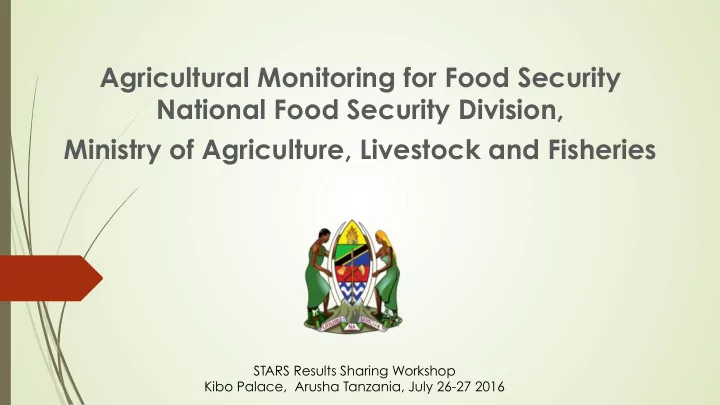

Agricultural Monitoring for Food Security National Food Security Division, Ministry of Agriculture, Livestock and Fisheries STARS Results Sharing Workshop Kibo Palace, Arusha Tanzania, July 26-27 2016
Introduction ´ Assessing crop growing conditions is a crucial aspect of monitoring food security in Tanzania. ´ In recent years, remote sensing based mapping and monitoring of the crops in the fields have been demonstrated using ground based observations (assessments) and others. ´ These efforts have been driven by the high demand for timely, more detailed and more accurate information on the crops for applications in both public and private sector, such as food security policy, crop and land management, infrastructure investment and crop insurance. ´ The basic principle being that better access to better information leads to eventual benefits for both producers and consumers through better investment and management at all levels.
Data Collection and Reporting at NFSD How NFSD has been collecting data ´ Weekly Reporting System (WRS) Tools ´ Snap Short Stories –SSS (Triple “S” analysis) ´ WRS1 - Production, yield, cultivated area ´ WRS2 - Phenological stages ´ WRS3 – Pest and diseases ´ WRS4 – Weekly market prices ´ WRS5 – Weekly rainfall ´ Jed 6 – Monthly price trends ´ Jed 7 – Monthly rainfall ´ RRS 1 – Vulnerability to food insecurity ´ Agricultural Routine Data System (ARDS) Challenges: cost, time, managing data collection process, data management, analysis
Adopting New Technology ´ In realizing these benefits the Ministry of Agriculture Livestock and Fisheries (MALF) through National Food Security Division (NFSD) is currently using the advanced satellite-based Global Agricultural Monitoring System Glam East Africa for nation-wide crop condition assessments. ´ Key areas currently applied includes the electronic field data collection with the GeoODK Android app and online database ´ Use of the Crop Monitor collaborative online portal integrating data entered by the regional analyst with remote sensing imagery time series. ´ The use of this new technology has shown improvement in providing accurate crop conditions information supported by maps and other evidence based information such as pest and diseases.
Remote Sensing Information ´ The main objective of using GEOGLAM technology is to reinforce the capacity to produce timely and accurate forecasts of agricultural production at national, regional and global scales by using Earth Observation data. ´ Free Access- can be used at anytime ´ Reduced subjectivity and increase objectivity in data collection and analysis ´ Provides relevant and reliable information that can support crop production and food supply estimates ´ Can support immediate informed decision
How we are doing it differently Managed to ease and improve crop monitoring and early warning activities through: ´ Use of Remote Sensing information from GLAM System ´ Use the crop Monitor Tool to summarize our assessments ´ Improved collaboration with other departments for information exchange e.g TMA ´ Identified capacity and data gaps
Further Needs and Requirements ´ Need more support and capacity building in the use of remote sensing data ´ Building capacity and engagement in field data collection using ODK portal ´ Support to inventories and possibly revival of data collection and digital delivery from more than 600 meteorological stations that are owned and managed by MALF ´ Capacity building on GIS and Remote sensing ´ Support in developing database at NFSD for all food security assessment data entries.
The Achievements ´ With all the tools, we are able to complete prototypes of the National Food Security Bulletin December January February March April May June
Challenges ´ Data quality and management still lacking ´ Inadequate knowledge and experience with modern field data collection tools-ODK ´ Insufficient rainfall stations for collecting rainfall data particularly at the farm level to support monitoring ´ Inadequate capacity on data analysis ´ Lack of capacity on production estimates especially yields and area using GIS and Remote sensing ´ inadequate skills for alternative data analysis ´ Budget constraints leading to delays of food security reports
Way Forward ´ Up-scaling lessons learned and tools to National Coverage ´ Advance work to produce timely monthly bulletins on crop conditions using GLAM derived data and field reports ´ Seek support from partners within the FAO, WFP, and FEWSNET in the development and continuance of the monthly bulletin
Summary We recognize and appreciate the support to the National Food Security Division particularly the Crop Monitoring and Early Warning Section through the STARS AgriSense Project. We recognize the value of the electronic field data collection tools being piloted in one of our region which not only ensures timeliness, but offers quality assurances avenues and would like to see this expanded to cover other regions.
Recommend
More recommend